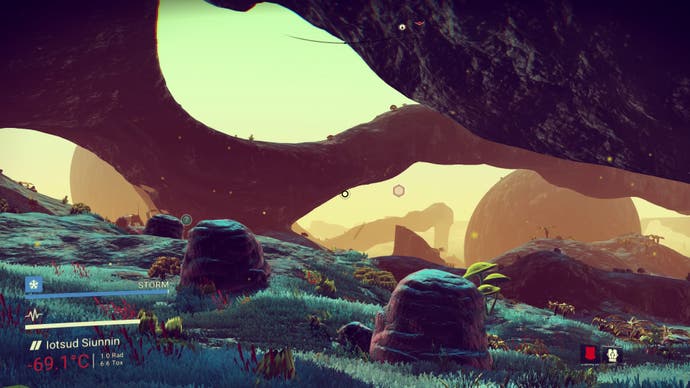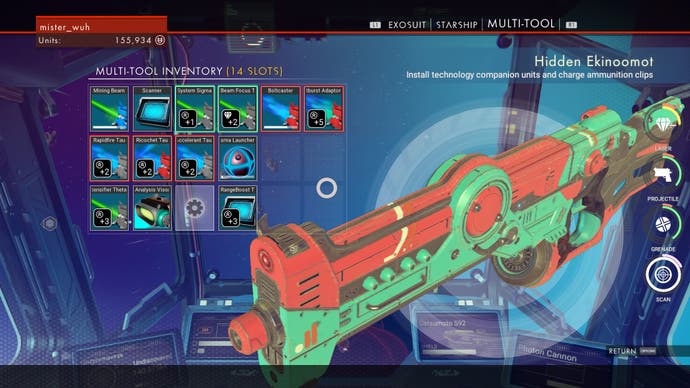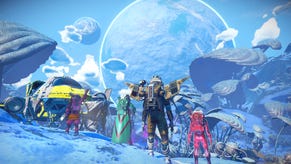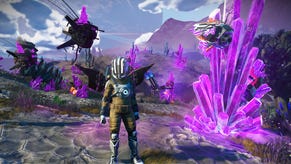No Man's Sky review
The discovery channel.
"Undiscovered." This word, appearing in tooltips that hover by waypoints, moons, planets and star systems, is No Man's Sky's sales pitch in a nutshell. In this remarkable game of space exploration, a universe has been born by algorithm, and it's so incomprehensibly vast that the chances of seeing anything another player has seen are vanishingly small. Your starting position is randomly selected. Even the wildlife is generated from an unthinkable number of variations. Every discovery you make is logged to the game servers and reported in those tooltips, so if anyone has been there before you, you'll know.
That little colony of knee-high, cat-eared Ewok-things scampering about on a dusty hillside? They're just for you; you can name them if you like. No-one else has ever laid eyes on the azure dell of Oximo Dale, sloping down to the ocean under the jade skies of Iotsud Siunnin. It's quite probable that no-one else ever will, and when you leave this star system behind, it will likely never be seen again. Drink in the sight of that silver-edged moon setting behind silhouetted mountains, because this glowering, scarlet sky is yours and yours alone.
The surprise is that it takes quite a long time - dozens of hours and star systems and planets, hundreds of light years - before a true appreciation of this sets in. To begin with, your sense of wonder is inspired by the sheer aesthetic bravura of the developers at Hello Games. They set out to create an entire universe of airbrushed sci-fi book covers and succeeded to an extent you wouldn't think possible. Even as beholden as it is to the vagaries of the algorithm, No Man's Sky is exotically gorgeous. That's thanks in large part to the spectrum of richly saturated colours used. Space glows with shimmering nebulae and planets are lush and strange. It can be a very lonely game, but it's never cold or drab.
The audio, too, is magnificent. The responsive ambient music by 65daysofstatic is ominous and thrilling, adding an edge of hard futurism to the luscious retro panorama. The sound design is rich, pushing ambient effects to the fore to give voice and physical presence to the ecologies you explore. Roaring dust storms, rustling flora, the eerie cries of the wildlife, and the fizzing and chattering of machines are layered into distinctly alien soundscapes you can picture with your eyes closed.

Some disappointment is inevitable once you've visited a handful of planets and started to see the limits of the algorithm. The parameters of weirdness in No Man's Sky have been quite strictly defined, and it gets repetitive. Look, here's another world of dog-things and dinosaur-things and little lumpy green groundhogs, of rock arches and caves of glowing minerals. There are limits to what Hello Games' artists can create, even if there are no limits to what the algorithm can do with it - and actually, if you want the game to look this good all the time, even the algorithm's style is going to be cramped. So a certain ennui does descend as you make your tenth, fifteenth, twentieth planetfall.
But then something great happens. As you get deeper into the game, you start to understand the algorithm's language, and gain a keener appreciation of the parameters at work. Once you've visited a planet with an extreme weather system, where you need to sprint from your starship to nearby shelter; once you've discovered planets barren of all life, or rich in certain rare minerals you need, or infested with aggressive security drones that hound you if you so much as mine some iron; once you've had to puzzle out how to island-hop across an ocean planet where fuel for your ship's launch thrusters is a rare find; then you start to really understand the character of a new world, and what it means for your endless journey into the stars. Land on a world with a mild climate, relaxed drone security, rich deposits and blue skies after a long string of harsh planetary encounters and you will feel the greatest joy of the explorer: the exultation of a great find.
None of this would happen if the game didn't have meaningful systems for you to engage with. While its structure is meandering and obscure, and its gameplay is unconventionally weighted, No Man's Sky is surprisingly methodical and densely packed with stuff to do. This is where it will prove most divisive, because it turns out to be a nitty-gritty game of resource-gathering, crafting, upgrading, and inventory management.

If you're the sort of person who enjoys the endless upgrade paths and soothing busywork of a massively multiplayer game like World of Warcraft, then No Man's Sky may well delight you, as it is a game in which these are the prime motivators. (For the record, I very much am.) If you're not, then it may frustrate or bore, especially since it also comes with some of the severe restrictions of survival games like DayZ. Managing your inventory is a constant worry, particularly at the start of the game when the carrying capacities of your starship and exosuit are very small. They can be expanded - in the case of your ship, by buying or salvaging a better one - but installing new technology upgrades also uses inventory space, and many valuable items don't stack, so the worry never goes away. I can understand the reasoning behind this: in space exploration, you can't take everything with you and resources should be limited. Also, hoovering up everything you see is one of several bad gaming habits that Hello Games is trying to get you to break. But the fiddling often bogs you down, and it's not always fun.
The upgrades themselves are richly satisfying. Nothing is more exciting than acquiring a new ship or multi-tool (a gun used for combat and mining) with more slots to equip more technologies, and some of these - notably the warp reactor upgrades, which allow you to jump greater distances through the galaxy and visit different kinds of star - are game-changing. It's also fun to play a game in which trading is meaningful, with some resources being genuinely scarce, and others randomly found according to the system you're in. The schematics themselves are only available as randomised drops from terminals, or encounters with the three races of sentient aliens exploring the galaxy alongside you. These encounters often unfold as little riddles which a greater understanding of an alien language - picked up from relics and 'knowledge stones' - will help solve. It's all very enigmatic and under-explained, giving you a rewarding sense of discovery as you connect the dots - and as in all the best games of this type, the web of systems draws tighter together the deeper you get into it.
If there's an outlier among those systems, it's the one you would find at the centre of most other games: combat. The sentinel robots that police planet surfaces are sometimes hostile, sometimes peaceable, though they will always attack if you try to blast your way into certain buildings. The fights are lacking in nuance and something of a chore, despite the enjoyably destructive modifications you can make to your multi-tool. Defending yourself (and others) from pirate raids in space combat is more satisfying, but only once you have upgraded your ship's weapons and shields; in the default ship, it's next to impossible.

For all that it takes from role-playing games, No Man's Sky eschews experience points in favour of an achievement-style 'journey' composed of 'milestones' in various disciplines: walking, space flight, combat, trading, survival in extreme conditions, collecting records of animal life, and so on. It's this that is used to manage your progress, with movement along the game's mysterious "paths" occasionally being gated according to your milestone level. You'll barely notice this at first, but later you might find yourself having to play the game in different ways in order to proceed. It's just another way in which No Man's Sky offers more friction - and gains more traction - the more you play it.
This is a surprising development, because while the game excels at giving you short-term and medium-term goals - or rather, encouraging you to find them yourself - when it comes to long-term goals, it is elusive to the point of aimlessness. Generally, you are assumed to be crossing the vast distance to the centre of the galaxy. What you'll find there has already been spoiled, and its merits ferociously debated; anything short of the meaning of life would fail to satisfy some people, and at least it's not a hollow stunt (unlike the centre of the cube in 22cans' mobile game Curiosity).
You are also encouraged to follow the path of the Atlas, a mysterious red orb that appears to you at the very start of the game. This storyline, if you can call it that, is inscrutable and grandiose, with philosophical overtones; it has more to do with Stanley Kubrick's version of 2001: A Space Odyssey than Arthur C. Clarke's. It offers some awesome spectacle, but little substance. (Assuming this is one of the "three paths" added in the day-one update, the jury's currently out on what the other two might be, but I won't spoil them by mentioning options.) No Man's Sky isn't always so portentous, though. The vignette encounters with alien races are written with a mixture of homely seriousness and quizzical humour that recalls Star Trek. That tone might not fit the visuals as well, but it's certainly a more inviting accompaniment to the life of a space nomad.

No Man's Sky struggles to resolve one central contradiction. The game was built to be infinite, and in practical terms it is. It's an endless, edgeless field possibilities. And yet it needs an endpoint, or at least a set of waypoints, to give purpose to your journey - to give you somewhere to be headed. This isn't just a matter of meeting gaming convention. No Man's Sky is brilliant - perhaps peerless - at evoking the classic science-fiction voyage into the stars. The further you go, the faster you travel, the more you learn and the more you see; never look back, because everything left behind is gone forever, while nothing ahead has been seen before. But to fully answer this seeking impulse, the game first has to give you a destination that means something to you - and that is something it only haltingly manages to do.
With much of the No Man's Sky's structure having apparently been added in the final month of development, that's not so surprising. (The patch notes are eye-opening; mere weeks ago, this was half the game it is now.) There is tremendous room for it to grow and improve. As it stands, it's flawed but completely intoxicating, a unique work of engineering art to lose yourself in. Sean Murray and his team at Hello Games set out with one goal: to create a game that is science fiction. Mission accomplished.

















